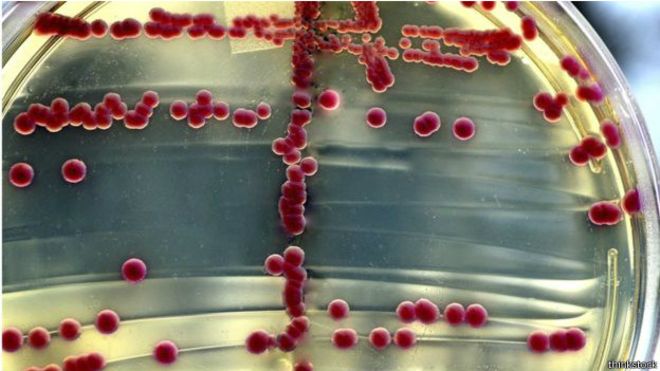Çiftliklerde antibiyotiksiz dönem çağrısı

İnsan sağlığına zararları nedeniyle tarımda kullanılan antibiyotiklerin büyük oranda kesilmesi gerekiyor.
İngiliz hükümetinin antibiyotiğe direnç gösteren bakteriler konusunda çalışma yapmakla görevlendirdiği ekip (Review on Antimicrobial Resistance) tarım sektöründe kullanılan antibiyotiklerin oranlarının yeniden belirlenmesini gerektiğini açıkladı.
Uzmanlara göre, bazı enfeksiyonlar fazla antibiyotik kullanımı nedeniyle tedavisi imkansız hale geliyor.
Dünyadaki antibiyotiklerin yarıdan fazlası daha hızlı büyümeleri için hayvanlar üstünde kullanılıyor.
Bilim insanları antibiyotik kolistinine dirençli bir bakterinin keşfedilmesinin ardından dünyanın “antibiyotik sonrası çağa” girdiği konusunda uyarıda bulunmuşlardı. Bu bakteri ilk önce çiftlik hayvanlarında görülmüştü.
Bazı durumlarda tarımda antibiyotik enfeksiyonların tedavisinde kullanılıyor ancak çoğunlukla sağlıklı hayvanların enfeksiyon kapmaması ya da kilo almaları için veriliyor.
Avrupa Birliği içinde antibiyotiklerin büyütme amaçlı kullanılması 2006’da yasaklanmıştı.
Bu tür kullanıma yoğun çiftçilikte daha sık rastlanıyor.
Mevcut oranlar dikkate alınırsa antibiyotiklerin küresel tüketimi 2030 yılında yüzde 67’yi bulacak. Sadece ABD’de her yıl hastalar için 3,400 ton, hayvanlar içinse 8,900 ton antibiyotik kullanılıyor.
Araştırmayı yürüten ekonomist Jim O’Neill rakamları “şok edici” şeklinde niteleyerek 2050 yılına kadar her yıl 10 milyon insanın ilaca dirençli enfeksiyonlar tarafından öleceğini söyledi.
O’Neill tarımsal antibiyotik tüketiminin 1kg çiftlik hayvanı başına 50mg oranında olması gerektiğini ifade etti. Buna Danimarka uyuyor.
İngiltere 1 kilogram başına 50 miligramdan biraz fazla, ABD ise kilo başına 200 mg antibiyotik kullanıyor. Kıbrıs’ta ise bu sayı kilo başına 400mg.
O’Neill pek çok çiftçinin bunu yaparsa fiyatın yükseleceği ve kendisinin batacağını düşüneceğini ifade ederken: “Danimarka örneği bize çok küçük bir geçiş maliyetiyle uzun vadede fiyatların etkilenmediğini ve piyasadaki payını koruduğunu gösterdi” dedi.
Antibiotic use in food fuels resistance to vital drugs – report
Tuesday 8 December 2015
Review on antimicrobial resistance warns that antibiotic use on animals outweighs that on humans in many countries, posing great health risk

A poultry farm in China. The report calls for a globally agreed limit of antibiotic use per kilo of livestock and fish in food production. Photograph: China Photos/Getty
The use of antibiotics in agriculture is fuelling drug resistance and must be cut back or even banned where they are important for humans, a report commissioned by David Cameron has warned.
The Review on Antimicrobial Resistance said global use of antimicrobials in food production at least matched that by humans, extending even to the widespread application in some areas of “last resort” antibiotics for humans – which cannot be replaced when ineffective – to animals.
Just as rising levels of human use of antibiotics are leading to growing resistance, the same is happening in agriculture, the review said in its latest paper, published on Tuesday. It acknowledges that the proper use of antibiotics is essential for treating infections in animals, as in humans, and offers considerable benefits for food production. But the authors say that “excessive and inappropriate” deployment, including to stop development of infections within a flock or herd, or simply to increase the pace at which animals gain weight, is a problem.
Jim O’Neill, the economist and former chairman of Goldman Sachs Asset Management who is chairing the review, said: “I find it staggering that in many countries, most of the consumption of antibiotics is in animals rather than humans. This creates a big resistance risk for everyone, which was highlighted by the recent Chinese finding of resistance to colistin, an important last-resort antibiotic that has been used extensively in animals.
“As we’ve highlighted, most of the scientific research provides evidence to support curtailing antibiotic use in agriculture. It’s time for policymakers to act on this. We need to radically reduce global use of antibiotics, and to do this we need world leaders to agree to an ambitious target to lower levels, along with restricting the use of antibiotics important to humans.”
The pig superbug and the baby: Watch the Guardian’s investigation into how intensive pig farming is accelerating an antibiotic crisis, that will be killing more of us, than cancer by 2050
The panel of experts undertook a review of 139 academic studies on antibiotic use in agriculture and found that only seven argued found no link between consumption in animals and resistance in humans, while 100 found evidence of a link. They argue therefore that there should be a limit for each country to reduce antibiotic use in food production to an agreed level per kilogram of livestock and fish.
They say this should be determined by experts, but suggest that a good starting point would be reducing levels to that of Denmark – an average of less than 50mg of antibiotics per year per kilogram of livestock in the country. Denmark has combined low use with being one of the world’s largest exporters of pork. The review also says that “countries need to come together and agree to restrict, or even ban, the use of antibiotics in animals that are important for humans”.
The experts also raise concerns over pollution during the manufacture of antimicrobials for human or veterinary use through waste products being discharged into water courses, a process it says could carry “a particular risk for resistance, because the concentrations of antimicrobials found in such scenarios can be many thousands, or even millions, of times higher than at sewage sites, for example”.
Nicholas Stern, president of the British Academy, said: “The routine and regular pumping of antibiotics into animals is deeply dangerous in that it creates resistance to drugs that are key to modern medicine and key to our lives and livelihoods. It is a classic example of short-term private interest in conflict with medium-term public good. In this case, the private gains are modest and the public damage is huge. It requires coordinated public action.”
- The headline on this article was amended on 7 December 2015 to remove the reference to “humans” in relation to resistance. The resistance develops not in humans, but in bacteria that can then infect humans.



